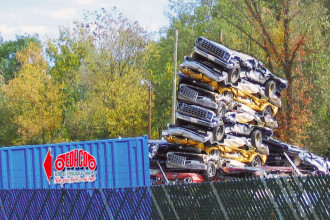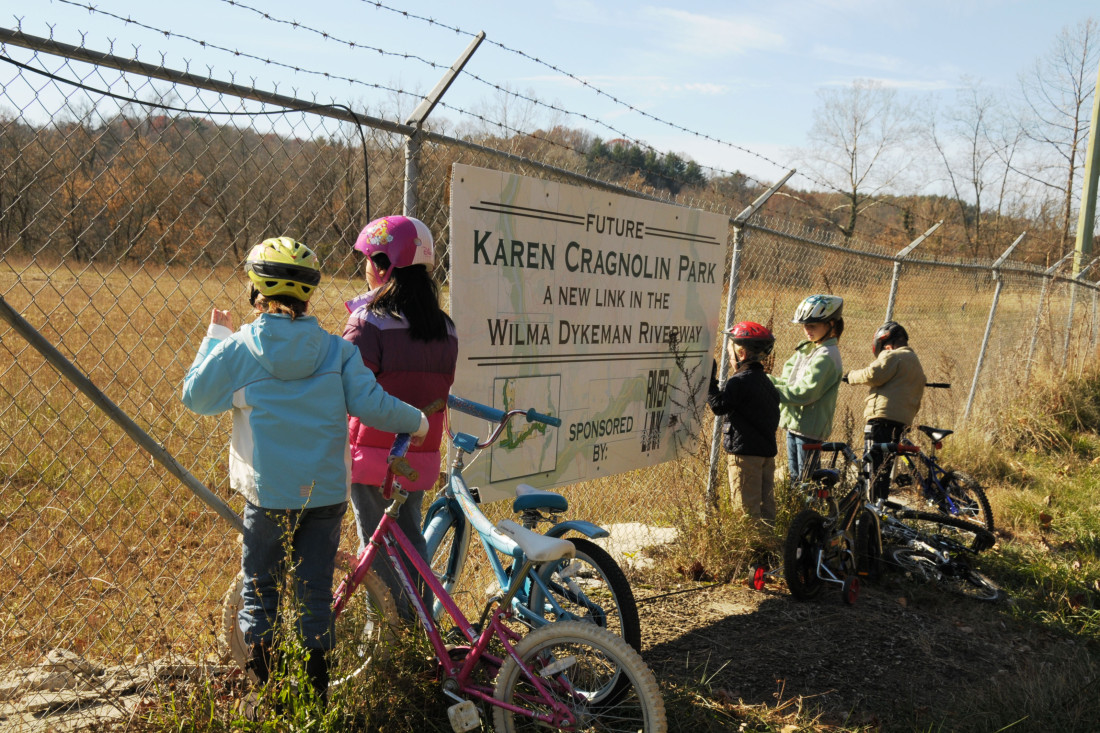“It was the worst possible scenario,” says Ari Ferro. The now-retired environmental scientist had just taken his first step onto the site of the former EDACO junkyard in the River Arts District, which he had been hired to clean up. The level of pollution, he recalls, had made the site “so damaged that there wasn’t much growing. It was just gravelly and looked like a moonscape.”
In October 2006, RiverLink, a local nonprofit that oversees the environmental and economic revitalization of the French Broad River and its watershed, had acquired the more than 5-acre site with the goal of turning it into a park. The land sits on Amboy Road between Carrier Park and the French Broad River Park, and once transformed into Karen Cragnolin Park — named for RiverLink founder Karen Cragnolin — it will connect the parkway system along the river’s western bank.
But before the property can fulfill that role, it must overcome its past as a junkyard. EDACO had used the site for car crushing for at least 40 years. As a result, the soil was highly polluted with oil, grease and diesel. When Ferro first tested the site, some areas were polluted with volatile organic compounds at levels three to four times above the regulatory requirements of the Environmental Protection Agency.
Another unanticipated problem greeted RiverLink when the organization arrived on-site: a layer of concrete covering the ground. “The former owner was worried that the city was going to take his property and convert it into a park,” says Garrett Artz, executive director of RiverLink. “So he allegedly invited all these dump trucks to pour out their leftover concrete at the site. In some places, the pile of concrete was 8 feet tall.”
Local company D.H. Griffin stepped in and recycled the concrete for free, over 100,000 total tons of material. After the concrete was removed, big tractors were brought to the site to work loads of composted yard waste into the soil. “We had to do quite a bit of ripping and tilling,” says Ferro.
Hidden helpers

The preliminary work took five years, but by 2011, it was time to focus on the contaminated soil. The cost of scraping up a foot or two of soil and bringing in new fill would have been prohibitive, so Cragnolin (who at the time was still executive director of RiverLink) went searching for a new solution. She found one in Ferro — and a natural technique called phytoremediation.
“Phytoremediation is basically the process by which plants stimulate soil bacteria,” explains Ferro. The plants increase the numbers and metabolic activity of soil bacteria, which in turn degrade soil contaminants. “The whole system gets pumped up by the presence of plants,” he says.
In layman’s terms, phytoremediation is as simple as adding plants, but some plants work better than others. Ferro planted tall fescue, a type of grass with an extensive and deep root system, to maximize available habitat for the beneficial soil bacteria.
“The bacteria are taking hydrocarbons and converting them into bacterial cell bodies,” explains Ferro. “In order for them to do that, they need nutrients.” To keep the bacteria happy, he added fertilizer to the site and irrigated to maintain soil moisture at optimal levels.
Ferro says that, left to its own devices, the contamination of petroleum hydrocarbons at the future park would eventually have disappeared on its own. “In 20 years, if you went out there and hadn’t planted, it would probably be pretty much cleaned up,” he says. Phytoremediation, however, speeds up the process by a factor of 10.
Testing, testing
Keeping tabs on the progress of phytoremediation posed its own challenges. The soil contaminants at the future Karen Cragnolin Park are heterogeneously distributed, says Ferro, so testing the soil is not straightforward. The footprint under a crushed car, for example, would have high levels of contaminants, but a spot of soil right next to it that didn’t bear the brunt of wreckage would be relatively free of hydrocarbons. “The baseline contaminant concentration could vary 100-fold within just a couple of inches,” says Ferro.
That variation made repeated sampling to measure decreasing contamination a futile effort. So Ferro devised a new system. He took composite samples from nine different treatment plots, tumbled all the soil in a cement mixer for a few hours, then took the mixtures out and put them in a set of “bridal veil” net bags, making a dozen bags for each plot.
Ferro then buried the bags 6 inches deep. “Within each set of bags, we were looking at the same soil sample,” explains Ferro. “Over a period of time — years now — we would dig them up and analyze them, and that was how we determined how fast the contaminants are going away.”
After seven or eight years of phytoremediation, only two spots on the property remain in excess of EPA contamination limits. “We could create the park and keep people out of those small areas,” says Artz. “But we are testing again at the end of July.”
People in place
The N.C. Department of Environmental Quality oversees the site under the N.C. Brownfields Program. Tracy Wahl, who supervises the program, says that even if the soil tests high, she doesn’t see contamination stalling plans for the park. “If [the samples are] clean, great. If not, we can minimize any exposure to anyone. We have talked about putting in a garden area or different types of trees so contaminated areas wouldn’t be appealing to walk through.”
RiverLink has already invited the public to help it move ahead with the site. The first open tour and design input session took place on July 17, with another scheduled for Monday, Oct. 29. By the end of 2018, Charlottesville, Va.-based landscape architecture firm Nelson Byrd Woltz will submit a handful of design options to the RiverLink board, and the winning design will become the park’s master plan.
Once the master plan is in place, RiverLink will begin fundraising in 2019. After money starts coming in, Artz estimates “it could be two or three years” until the park opens. But no matter when that time comes, he doesn’t want the community to forget that Cragnolin’s vision and tenacity prepared the site to enjoy its new future.
“This site really does tell her story better than the other 10 or 12 sites we could talk about. “Most of us would have seen the junkyard and said, ‘That’s just too damaged to do anything about,’” says Artz. “Now, we’re going to create a park. That was all Karen’s vision. That’s what she was really good at: seeing something where nobody else could and knowing that it could be something special.”




What a wonderful project. Karen should be thanked by everyone in Asheville for her great work and ideas. Another person to be proud of in this great city. Great because of people like Karen Cragnolin and others who have brought this property a new life and years of enjoyment in the future!
A great project with really good leadership. Ari Ferro is a master phytoremediation scientist – very nice!